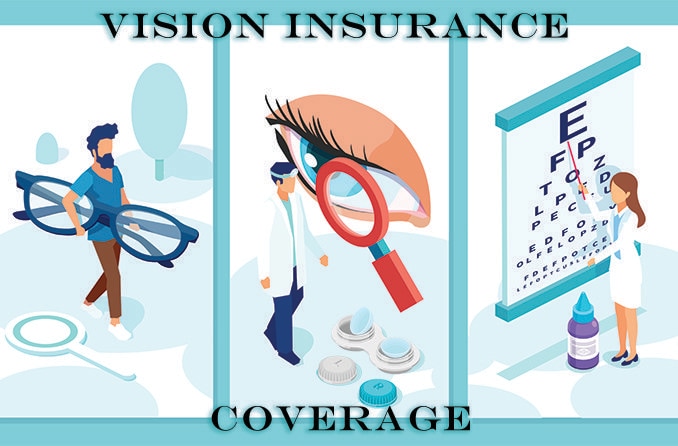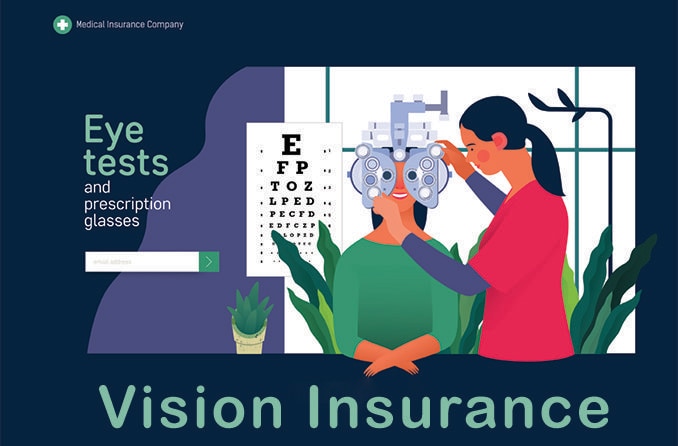What does vision insurance usually cover?
Vision insurance helps cover some of the cost of routine eye care. While the amount of coverage can vary by plan, most include:
Routine eye exams
Vision insurance plans generally cover annual comprehensive eye exams. These preventive exams detect refractive errors, like myopia (nearsightedness) and hyperopia (farsightedness), and can help identify signs of other eye problems. Some vision insurance plans also provide coverage for contact lens exams, which differ from exams for glasses.
Vision plans often require an eye exam copay at the time of service.
Eyeglass frames and lenses
Vision plans typically offer coverage for eyeglass frames and prescription lenses:
Frames
Many plans set “allowances” for eyeglass frames. An allowance is a specific dollar amount that the plan will pay toward a pair of frames. If your frames cost more than that amount, you’ll need to pay the difference out of pocket.
Frame allowance varies by factors, like plan type and geographic location, but it generally covers the average frame cost. Some plans allow for the purchase of new frames every one to two years.
Prescription lenses
Most vision insurance plans help pay for standard single-vision and multifocal lenses (such as bifocals, trifocals and progressives). Like frames, most plans provide a lens allowance every one to two years. However, the copays for premium or custom lenses are often higher.
Lens enhancements may also be covered under some plans or available at a reduced cost. These can include:
- Scratch-resistant coating
- Ultraviolet (UV) protective coating
- Anti-reflective coating
- Photochromic lenses
- Lens tints
Contact lenses
Many plans offer a contact lens allowance up to a certain dollar amount per year. Coverage for the contact lens fitting and evaluation may also be offered at a reduced rate or with a copay.
In general, vision insurance plans may allow you to use benefits toward either contact lenses or glasses in a given year, but usually not both. If you need glasses and contact lenses, you might consider alternating your benefits, using them for glasses one year and contacts the next.
The allowance and copays for contacts may also vary, depending on whether the lenses are elective or medically necessary. Some plans have different stipulations, though, so it’s best to review your policy details carefully.
What typically isn’t covered by vision insurance?
Vision insurance generally does not cover services, surgeries or treatments involving eye diseases, conditions, injuries and other medical issues. This includes diagnostic or medical testing for eye conditions or diseases. However, your health insurance may cover these types of care.
Other items that usually aren’t eligible for coverage under vision insurance plans include:
- Non-prescription eyeglasses, contact lenses and sunglasses
- Reading glasses
- Additional eye exams (most plans allow one exam per year)
- Over-the-counter or prescription medications
If you have a health savings account (HSA) or a flexible spending account (FSA), you may be able to use those funds to pay for certain expenses not covered by your vision insurance.
READ MORE: Can I use my HSA or FSA for glasses?
Laser vision correction
Laser vision correction surgeries, like LASIK and PRK, usually aren’t covered by vision insurance since they’re considered “elective” procedures. But some plans provide discounts on these surgeries when you use certain network providers. The discounts may be a percentage off the total cost or a set dollar amount.
Similar to other non-covered vision expenses, an HSA or FSA plan may be used to pay for laser vision correction.
How do you get vision insurance?
There are two primary ways to enroll in a vision insurance plan:
Employer-sponsored plans
Some employers offer vision insurance for employees, their spouses and dependents as an employment benefit. Employers may cover all or part of the monthly premiums, with the premiums made as a payroll deduction.
Enrollment in an employer-sponsored plan is often allowed during a certain time of year, referred to as the “open enrollment period.” This is typically toward the end of the calendar year but can vary by company.
Standalone plans
If you don’t have access to an employer-sponsored vision plan, you can purchase a standalone individual or family plan directly from an insurance company or an insurance benefits company. These plans often allow enrollment at any time. With a standalone plan, you are responsible for paying the full monthly premiums.
Vision coverage for children through the Health Insurance Marketplace
Health care plans usually do not provide vision coverage for adults. However, health insurance purchased through the Health Insurance Marketplace offers coverage for children (typically through age 19). This may include coverage for eye exams, eyeglasses and contact lenses. Copays, deductibles and other associated costs may apply, depending on the plan.
SEE RELATED: Why vision insurance for kids is important
How much does vision insurance cost?
Vision insurance costs vary, depending on the plan type, where you live and your age. Overall, these costs can include:
- Premiums – The amount you pay monthly to subscribe to a vision plan. This ranges from around $5 to $30 or more per month on average.
- Copays – The amount you pay at the time of care for covered services or items, such as eye exams or prescription eyeglass lenses. Most vision copays are a fixed amount and range between $0 and $40, though some can be more.
- Deductible – The amount you pay toward your vision care before your plan begins covering costs. However, most vision plans don’t have a deductible like other types of health insurance.
- Other fees – Some vision insurance plans also carry enrollment or other administrative fees.
Is vision insurance worth it for you?
Even if you don’t wear glasses or contacts, vision insurance is still beneficial. It helps cover the cost of annual eye exams, which are essential to monitor your eye health and vision. These exams help detect signs of eye diseases and other conditions as early as possible.
To determine if vision insurance is right for you, consider the following factors:
- Corrective eyewear needs – Whether you wear prescription glasses or contact lenses
- Eyewear costs – The amount you typically spend on prescription eyewear, including eyeglass frames, lenses and contacts
- Coverage needs – Whether you need vision insurance for yourself or also for dependents (such as a spouse or children)
- Plan costs – The total costs associated with the plan, including premiums, copays and any additional fees
- Coverage limits – The total allowance for eye exams, glasses, contacts and any restrictions on frequency
- Alternative options – Whether you have access to an HSA, an FSA or other benefits that could help cover your vision care expenses
Understanding your vision needs and estimated insurance costs can help you decide whether a vision plan can save you money versus paying out of pocket.
Frequently asked questions about vision insurance
If you’re considering vision insurance, you probably have other questions about how it works and what you can expect. Below are some of the more commonly asked questions and answers about this type of insurance:
Is there a waiting period before I can use my vision insurance?
Some health insurance plans have a waiting period, which is a set period of time before you can begin using your benefits. But many vision plans do not. Without a waiting period, you can usually use your benefits right away. Be sure to check your plan details to understand your specific coverage.
How often can I get new glasses or contacts?
The frequency of coverage for glasses or contacts depends on your plan. Most plans provide benefits every 12 months or 24 months. This means you may be eligible for new glasses or contacts once a year or every two years when your plan renews.
Can I add my children or spouse to my vision plan?
You can generally add children and spouses to your vision plan. However, eligibility may depend on the plan type and rules. For instance:
Employer-sponsored plans
Many employers extend benefits coverage to spouses and children of their employees. If family coverage is offered, you may need to wait until the open enrollment period to add dependents. However, you might also be able to add them if you experience a qualifying event, such as a birth, adoption or marriage.
Some plans have age restrictions for children (for example, children over 26) or other rules for adding dependents.
Standalone plans
Many vision insurance companies offer plans for individuals and families. Like employer-sponsored plans, adding dependents may be limited to the open enrollment period unless a special enrollment period is allowed for qualifying life events. Age restrictions and other rules may also apply.
Check with your employer or insurance company to see if family coverage is available and when dependents can be added. Keep in mind that adding family members may increase your monthly premium.
What happens if I use an out-of-network retailer or eye doctor?
You may be able to use an out-of-network provider or retailer, depending on your plan. But you might have to pay more out of pocket, and you may need to file a claim for any allowable reimbursement. Staying in-network can help you save money on the cost of routine exams, eyewear and other services.
READ NEXT: Do Medicare and Medicaid offer vision benefits










